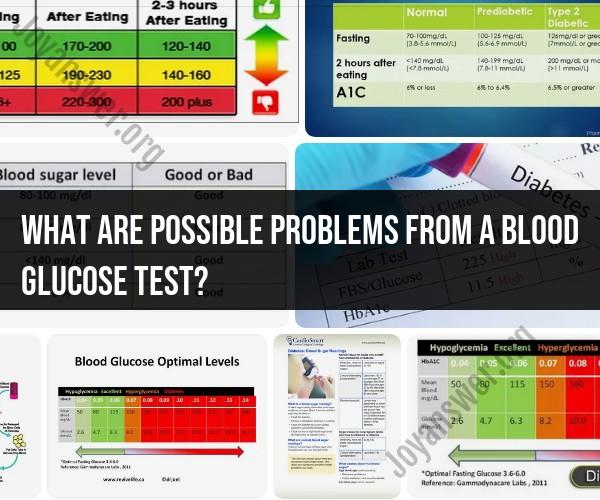What are possible problems from a blood glucose test?
Blood glucose tests are crucial for managing and monitoring diabetes and other conditions related to blood sugar levels. However, there can be various problems or issues that may affect the accuracy or reliability of blood glucose test results. Here are some common problems and their potential solutions:
1. Insufficient Blood Sample:
- Problem: Not obtaining enough blood for the test strip can lead to inaccurate results.
- Solution: Ensure you have a sufficient blood sample by following the instructions provided with your glucose meter. Use the appropriate lancing device and adjust the depth setting as needed. Warm your hands or fingers if blood flow is slow.
2. Contaminated Test Strips:
- Problem: Using expired or contaminated test strips can lead to inaccurate readings.
- Solution: Check the expiration date on your test strip container and only use strips that are within their expiration date. Keep the strips in a dry, cool place and close the container tightly after use.
3. Inaccurate Calibration:
- Problem: Failure to calibrate your glucose meter or using the wrong calibration code can result in incorrect readings.
- Solution: Ensure your meter is properly calibrated according to the manufacturer's instructions. Use the correct code or settings if required.
4. Meter Not Clean:
- Problem: A dirty or contaminated glucose meter or test strip port can affect the accuracy of readings.
- Solution: Clean your glucose meter and the test strip port regularly as recommended by the manufacturer. Use alcohol wipes or a soft, lint-free cloth.
5. Hematocrit or Oxygen Saturation Levels:
- Problem: Some meters may be affected by high or low hematocrit levels (the percentage of red blood cells in the blood) or low oxygen saturation levels.
- Solution: If you have a medical condition that affects these levels, consult with your healthcare provider to ensure accurate testing or use a meter that is less sensitive to hematocrit and oxygen saturation variations.
6. User Error:
- Problem: User error, such as misinterpreting results or not following the testing instructions correctly, can lead to inaccurate readings.
- Solution: Read and follow the manufacturer's instructions carefully. If you have questions or concerns about your testing technique, consult with your healthcare provider or a diabetes educator.
7. Environmental Factors:
- Problem: Extreme temperatures, humidity, or altitude can affect test strips and meters.
- Solution: Store your glucose meter and test strips in the recommended environmental conditions specified by the manufacturer. Avoid exposing them to extreme heat, cold, or moisture.
8. Medication Interference:
- Problem: Certain medications or substances can interfere with blood glucose readings.
- Solution: Be aware of any potential interactions between your medications and blood glucose tests. Consult with your healthcare provider if you suspect medication interference.
If you encounter persistently inaccurate or unusual blood glucose readings, it's essential to consult with your healthcare provider or diabetes educator. They can help troubleshoot the issue, ensure proper testing techniques, and determine if any adjustments to your diabetes management plan are necessary. Regular calibration and maintenance of your glucose meter, along with adherence to testing guidelines, can help minimize problems and ensure accurate results.
Limitations and Factors that Can Affect Blood Glucose Test Results
Blood glucose tests are a valuable tool for monitoring blood sugar levels, but they are not perfect. There are a number of factors that can affect the accuracy of blood glucose test results, including:
- The type of blood glucose test: There are two main types of blood glucose tests: capillary blood glucose (CBG) tests and venous blood glucose (VBG) tests. CBG tests are done by pricking a fingertip and collecting a small sample of blood. VBG tests are done by drawing blood from a vein. VBG tests are generally more accurate than CBG tests, but they are also more invasive.
- The timing of the test: Blood glucose levels can fluctuate throughout the day, so it is important to test at the same time each day for consistent results.
- Food intake: Eating can cause blood glucose levels to rise. It is important to wait at least two hours after eating before testing your blood glucose.
- Exercise: Exercise can cause blood glucose levels to drop. It is important to test your blood glucose before and after exercise to avoid low blood sugar (hypoglycemia).
- Medications: Certain medications can affect blood glucose levels. It is important to talk to your doctor about how your medications may affect your blood sugar levels.
- Other medical conditions: Certain medical conditions, such as diabetes, pregnancy, and kidney disease, can affect blood glucose levels.
Improving Accuracy of Blood Sugar Readings
To improve the accuracy of your blood glucose test results, you should:
- Wash your hands thoroughly with soap and water before testing.
- Use a clean lancet to prick your finger.
- Apply a small amount of blood to the test strip.
- Follow the instructions on your blood glucose meter carefully.
- Record your blood glucose results in a logbook.
What to Know About Diagnosing Diabetes From Glucose Tests
Diabetes is a chronic disease that affects how your body turns food into energy. There are two main types of diabetes: type 1 diabetes and type 2 diabetes.
Type 1 diabetes is an autoimmune disease that causes your body to attack the cells in your pancreas that produce insulin. Insulin is a hormone that helps your body use glucose for energy.
Type 2 diabetes is a more common form of diabetes that occurs when your body becomes resistant to insulin or doesn't produce enough insulin.
Blood glucose tests can be used to diagnose diabetes. However, it is important to note that a single blood glucose test is not enough to diagnose diabetes. Your doctor will need to order additional tests to confirm a diagnosis of diabetes.
Here are the criteria for diagnosing diabetes using blood glucose tests:
- Fasting blood glucose (FBG): An FBG level of 126 milligrams per deciliter (mg/dL) or higher on two separate tests indicates diabetes.
- Random blood glucose (RBG): An RBG level of 200 mg/dL or higher on two separate tests indicates diabetes.
- Oral glucose tolerance test (OGTT): A two-hour OGTT level of 200 mg/dL or higher indicates diabetes.
If you have any questions or concerns about your blood glucose test results, be sure to talk to your doctor.













